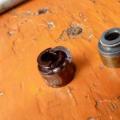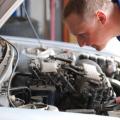updated B. 23:56 22.10 20:55 31.10.2015
Overview of equipment
In this article, we will help you understand how to choose a fuel level sensor to your transport. In the last decade, the technology of remote transport control was widely distributed in Russia, in particular the level of fuel levels. Fuel consumption control systems are not only convenient, but also beneficial from an economic point of view. They allow at any time to familiarize themselves with the amount of refueling, as well as the compliance of the calculations of the real volume of fuel in the tank vehicle.
The main component of any fuel control system is the fuel level sensor (hereinafter referred to). It looks like this:

The Dut is attached to the GPS \\ GLONASS terminal, usually installed in the vehicle cabin, and transmits data on the fuel level at each time of time via a wired or wireless communication channel. The quality of control depends on the type and quality of the Dutie, so it is important to make the right choice here.
Principle of operation of the fuel level sensor
Let's start with the basics with the physical principle, on the basis of which control is carried out. At the moment the vast majority of doors in the market are capacitive sensors. As a rule, the fuel level sensor consists of two structurally combined elements: a capacitive level sensor and a converter ("head"). The capacitive level sensor is a condenser in which one Obp is made in the form of an aluminum tube, a diameter of about 20 mm, and the second convection is inserted into the first and is made in the form of a tube or a smaller diameter rod. Between the plates are fastening elements. As is known, the capacitance of the capacitor depends on the properties of the dielectric located between the condenser plates. In our case, the dielectric serves as air and fuel - when the fuel level changes, the ratio between air and fuel changes, which leads to a change in the capacity - the converter measures the capacitor capacity and converts this value to the code or measuring signal. Thus, the dut can be used to measure the level of dielectric impermeable liquids, which include all petroleum products and some oils. The presence of water or other electrically conductive liquids in the fuel often leads to the issuance of incorrect measurement results. Many are duting the central rod is isolated, which allows the use of an instrument for measurement, including in electrically conductive fluids. The main goal of isolation is to do it less sensitive to electrically conductive additives that may be in fuel, such as water. So, S. common principles Understood.
What kind of fuel level sensor parameters should be considered?
Fuel level sensors are divided by mechanical properties - on whole and collapsible.
The collapsible fuel level sensors are a design of 3 elements - this is a measuring tube, fastening flange and measuring head. When installing, first the flange is attached to the tank, the rod is screwed into it (although it happens that the rod is screwed into the flange and before installation), the measuring head is installed finally.
One-piece fuel level sensors are a rigid indivisible design. Such a design is considered more reliable, due to the issues of connecting elements, which often have a backlash and can be recalled over time.
According to the type of output signal, the fuel level sensors are divided into analog and digital.
- Analog fuel level sensors transmit the measured value by one of the characteristics of the electrical signal - this is a voltage, frequency or current. The voltage is the most common type of transmission, but at the same time most susceptible to interference and external influence, so it should be used only in the absence of an alternative. Transmission of current strength, or "current loop" - the method widely used in production management systems, in the data collection systems of laboratory equipment due to the stability of the output signal and reading accuracy. At the moment, in monitoring systems, such a type of measurement transmission occurs infrequently, but due to high accuracy and development this method In other industries, it is possible to expect that in SMT systems (satellite monitoring of the TusNport) in a short time it will become a new standard. The transmission of the signal in frequency is also practically not subject to external influence. Thus, when solving, use an analog fuel level sensor, it is recommended to use a device with frequency transmission of measured values, or the transmission of measurements to output the "current loop". You also need to know that when using analog sensors, the maximum possible number of connected sensors is limited by the number of inputs of the data acquisition terminal.
- Digital fuel level sensors transmit a digital interface signal in the form of a digital code. The most common RS232 and RS485, there are also fuel level sensors with CAN standards. Consider all interfaces in more detail .rs232 - the technology that was created for telephony and modems, and then became an industrial standard for many types of equipment. From the point of view of stability and reliability there are no complaints, but there is an inconvenience of a physical nature - only one device can be connected to one port. Thus, if you have two tanks on one machine, or you want to track the level in several tanks when using the RS232 sensors, you will need a device that has the required number of ports, which is actually found rarely.
CAN Code Transfer
The following option is the transmission of the code for the RS485 bus. RS485 - originally designed for industrial automation, therefore devoid of RS232 deficiencies, in particular, one port can be suspended by several sensors (as a rule, the quantity depends on the driver's capabilities and the specific implementation of the output of the terminal developer). Therefore, when using digital fuel sensors, it is preferable to stay at this option.
Data transmission by RS232 and RS485 is carried out using the LLS protocol developed by Omnicomm. This protocol is de facto standard in the industry, and most default equipment manufacturers include support for this protocol to their equipment, so compatibility problems occur extremely rarely. This means that if you have installed equipment with the RS232 or RS485 interface, you can safely take a dip with any of these interfaces, and you will not have compatibility issues.
Transmission of data on the CAN intrinfeasse is theoretically more universal and informative than other standards, since the CAN standard is a data transfer standard. automotive industry. Unfortunately, not all terminals have a given interface, and even if there is such an interface, the device protocol may not be added.
Error of the fuel level sensor
The overwhelming majority of manufacturers declares measurement errors no more than 1%, but in fact the error depends on the competent and high-quality installation, as well as the correct sensor targeting. In this parameter, we will not stop in detail, the only thing that can be said definitely is that digital sensors provide higher accuracy due to higher "sensitivity".
On which basic characteristics need to be stopped when choosing a fuel level sensor
- The signal transmission method is analog or digital. It is preferable to use digital dules, best according to the RS-485 standard
- The length of the basic dutie. Many manufacturers have a standard sensor length, as a rule, 70 - 80 cm, longer sensors must be ordered separately, with many models of specials. And agricultural machinery the depth of the tank reaches one meter.
- Complete set. At this point you need to pay the most careful attention, because the better delivery package, the lower the likelihood that the sensor setting will be made incorrectly. The minimum equipment should include, in addition to the sensor itself, rubber gasket between the flange and the tank, the set of fastening screws, a wire filling, or plastic.
- The presence of protection for nutrition and galvanic junction. The greater the value of protection against the voltage jump, the better. The presence of galvanic junction guarantees the maintenance of the operability of the signal circuits of the Duta with voltage jumps. Many manufacturers refuse galvanic junction and put only a capacitor that does not save with high voltage jumps. For example, in a novelty of this year, the "Level M1" from the company "Barc-M" is an interchange of signaling chains and power circuit, which allows you to protect the sensor from burnout if the driver will start the machine when the mass is disabled. Pay special attention to this parameter, It is not implemented by all manufacturers.
Construction and fastening flange. In this case, you need to be viewed on the basis of the situation. If you choose sensors for a fleet (which has not yet been equipped with sensors) - there is almost no difference; If you take to replace any sensor - try to take with the same fastening system to simplify the replacement, or with the presence of universal fastening adapters. For example, the presence of a replaceable flange in sets of some sensors allows you to integrate the sensor into any seats of the car. Given the fact that a large number of transport today is already equipped with fuel level sensors, a replaceable flange allows you to replace the sensor of any third-party manufacturer without an additional time loss.
Sensor case material. As a rule, metal or plastic is used, the metal is certainly more preferable, since it provides greater resistance of the measuring mechanism of the sensor to shock and mechanical loads. In addition, the metal case is provided to protect against external electromagnetic effects.
The table presents the main characteristics of the most popular, to date, fuel level sensors. Green We allocated the advantages of each sensor.
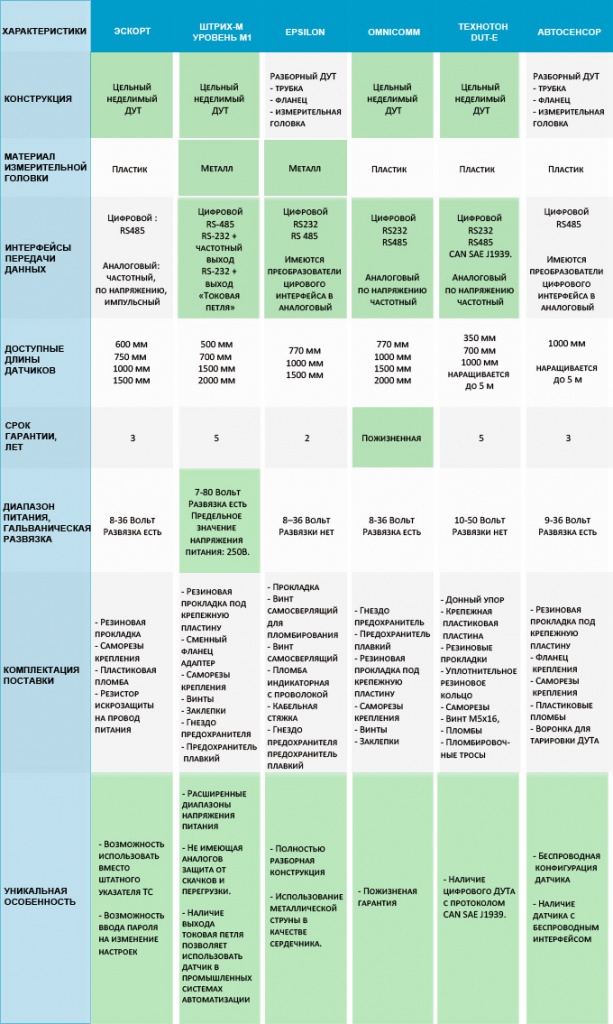
Pros and cons of the three best fuel level sensors (Dut)
Comparing the devices, you can select three devices that are able to meet the needs of almost any vehicle owner. Consider the pros and cons of these devices.
- Sensor of the company "ESCORT"it has a good reliability and functionality ratio. Of the advantages, I noted the possibility of loading a target table, blocking access to the settings of the password is found as a regular fuel level meter. The sensors of the ESCORT can produce an emergency residue of the fuel and is reflashing in the field. One of the advantages of the sensor from the company "ESCORT" is the well-thought-out equipment, which provides the convenience of mounting. From the minuses of this document, I can mark the protection of the voltage jumps in comparison with competitors.
- Also, I would pay attention to sensor "Level M1" from the company "Strich-M". Although this solution is new on the market, the experience of the manufacturer's company in the production of automotive electronics is very significant (the company "Barch-M" produces, including tachographs and transport automation systems). The "Level M1" sensor has the unique characteristics of power protection - this range of voltage drops cannot withstand no other forth, which provides stability to many external influences and stability of work on technique with faulty electrical wiring (relevant on fleets with old worn technology).
From the plus fuel level sensors from the company "Omnicomm"it is possible to note the company's many years of experience and a well-deserved brand - standard stability and reliability. On each fuel sensor distributed life warranty manufacturer. The device allows flexible setting of limits and properties of output signals. The output signal level does not depend on the supply voltage, so that the sensor can be used in conjunction with any terminal having a measuring input in frequency or voltage. The measuring element of the sensors is made of corrosion-resistant aluminum alloy. The protection of the electrical cable from mechanical and atmospheric influences provides the germina and metalwork. The device has a convenient configurator (for configuration). A multi-level system for learning integrators and end users allows you to exclude errors when installing this equipment. Of the minuses, I can note the company's high price policy and in recent years a decline in devices reliability indicators, judging by consumer reviews.
To date, the main reason for the exit is built is the voltage differences caused by a car malfunction or sabotage from drivers, this solution guarantees stable operation in all cases described. Another advantage of this device is a fastener, which is hidden in the sensor housing. A very convenient solution when the fasteners are used inside the body of the sensor and closed on top of the lid. Lack of access to fasteners significantly reduces the likelihood of interference in its work of third parties. The exit of the "current loop" allows the use of the "Level M1" sensor in industrial systems of dispatching and control (for example, control of the oil level in tanks, etc.). This type of measurement transmission is now infrequently found, but due to the high accuracy and prevalence of this method in other industries, it can be expected that in the SMT systems in a short time it will become a new standard. And of course, the indisputable plus of Dut M1 is its value, which is lower than most competitors.
Good day, our dear readers. In today's article we will tell about such useful device As a fuel level sensor, the low indicators of which are definitely upset by each driver.
Still would! When gasoline ends (or other fuel), the choice of the owner of the vehicle is small: either again refuel the car, and today it is the cheapest pleasure, or begin to lead an active lifestyle and walk. Of course, mostly, everyone always chooses the first option, but probably should not be made to situations when the decision has to be taken immediately. This is designed to help the fuel level sensor.
Functional features of the device
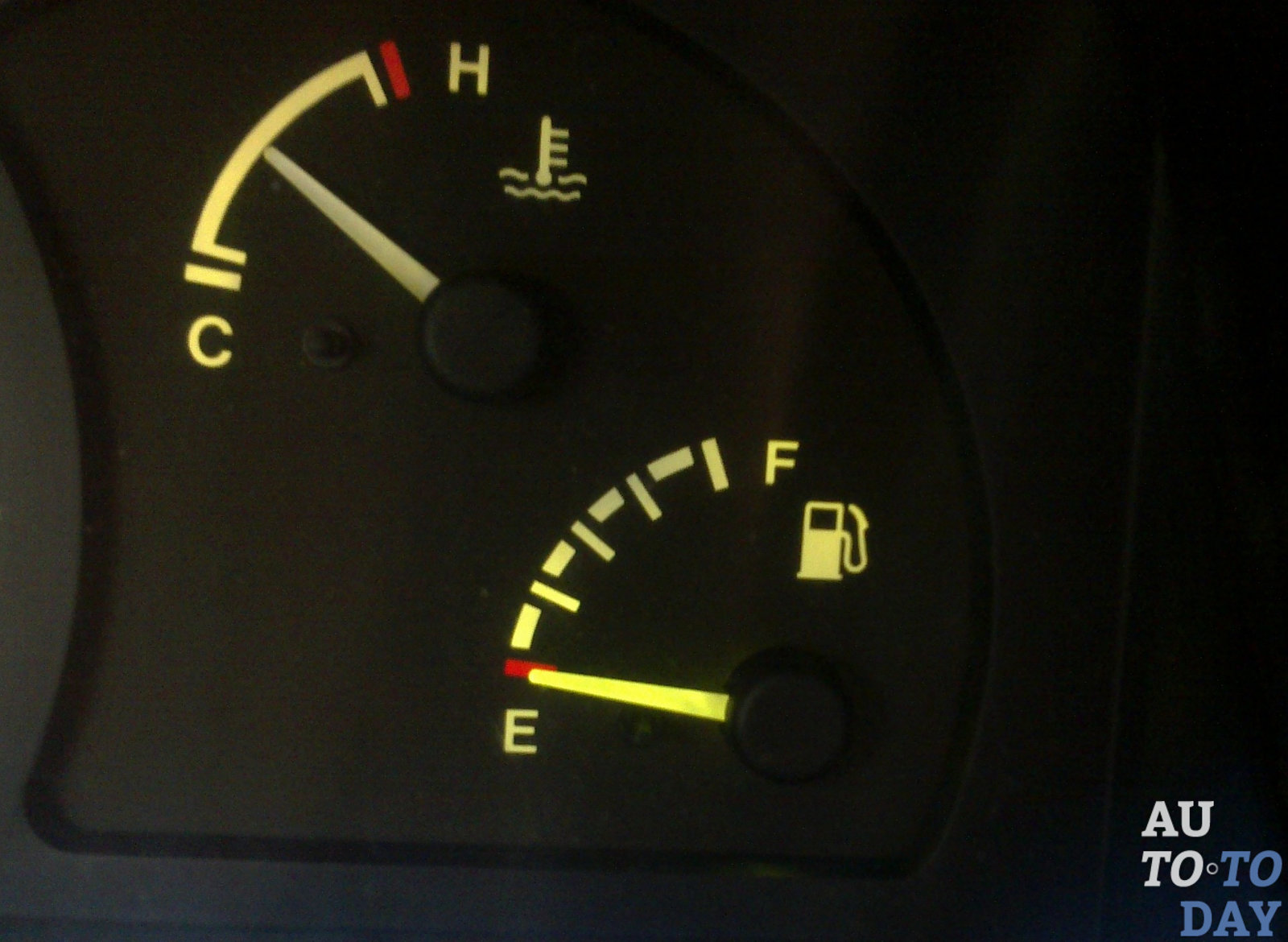 Fuel Level Sensor (Dut) - device intended for measurement and control of fuel and lubricants (gasoline, diesel fuel, oil) on vehicles and relevant warehouses. We will not consider its functions in warehouse work and focus on cars, where it is used to designate the fuel level, the level conversion into the volume, transmission of the obtained value over an analog or digital path.
Fuel Level Sensor (Dut) - device intended for measurement and control of fuel and lubricants (gasoline, diesel fuel, oil) on vehicles and relevant warehouses. We will not consider its functions in warehouse work and focus on cars, where it is used to designate the fuel level, the level conversion into the volume, transmission of the obtained value over an analog or digital path.
The device can be used as an addition to the mapping devices or controllers, with the possibility of programming having the characteristics of input electrical signals that meet its technical requirements.
The main purpose of the vehicle fuel level sensor is to measure the volume and fuel level in the tanks, most often the gas tanks (with the exception of diesel and gas vehicles). Such a device made of a metal rod installed in the fuel tank (tank), through a standard hole, or a specially made hole suitable for diameter. The sensor is connected to the monitoring system of the machine to which the necessary information is transmitted.
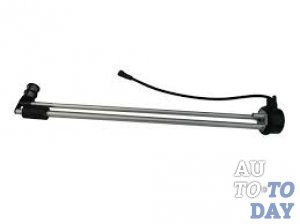 Most often, they are high-precision devices universal typeWhat makes it possible to use them not only on cars, but also on other technique and even stationary objects (warehouses, factories). This device "Collaborates" with a fuel level pointer, which is located on the dashboard.
Most often, they are high-precision devices universal typeWhat makes it possible to use them not only on cars, but also on other technique and even stationary objects (warehouses, factories). This device "Collaborates" with a fuel level pointer, which is located on the dashboard.
Nowadays, there are several options for fuel level sensors (electronic, digital, float, ultrasonic, universal), but they all pursue one common goal - to properly determine the consumption of the contents of the tank, whatever the driver can control its fuel costs. In addition, the device will allow you to monitor the volume of plum (especially useful feature For enterprise executives, taxi services and other organizations, where employees can drain government gasoline) and fuel refueling (where, when and in what quantity).
What would be able to control the fuel level in more detail should be installed on the vehicle to the appropriate device with increased sensitivity and the minimum error, which will ensure the most accurate indicators.
Principle of operation of the sensor
Place the fuel level sensor can be in any car tank, including with diesel system. The testimony will be displayed on dashboard Vehicle, where a special pointer is provided for these purposes.
Modern tanks have the most different shape and design, for which it is necessary to pay attention to, since this fact affects the amount of fuel. The sensor placed in the tank does not immediately begin to feed the correct signals about its filling, as some time displays the filling of the entire tank and only then the numbers are lowered to the right level. True, if you believe the statistics, none such a device provides absolutely accurate readings.
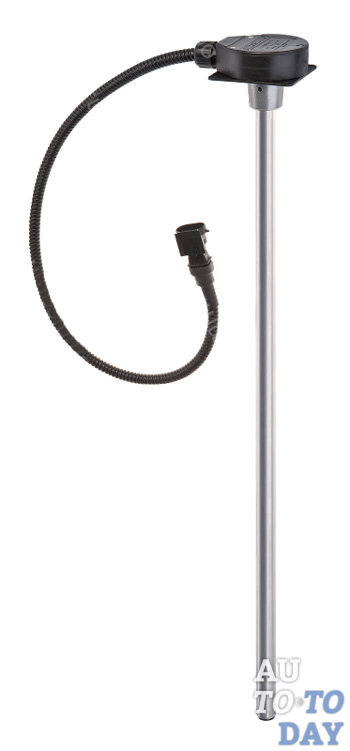 The principle of operation of the sensor is based on the compliance value of the fuel level by a specific signal, depending on which devices with a digital and analog signal differ. Analog sensors have a high percentage of inaccuracy, which is why it is already practically not used. The digital sensor "translates" an analog signal in the "digit", and then adjusts and levels errors in measurements caused by uneven fuel level and tank geometry. It is this type of device that provides the most accurate indicators, and the errors may be present only at the stage of physical measurement of the fuel level.
The principle of operation of the sensor is based on the compliance value of the fuel level by a specific signal, depending on which devices with a digital and analog signal differ. Analog sensors have a high percentage of inaccuracy, which is why it is already practically not used. The digital sensor "translates" an analog signal in the "digit", and then adjusts and levels errors in measurements caused by uneven fuel level and tank geometry. It is this type of device that provides the most accurate indicators, and the errors may be present only at the stage of physical measurement of the fuel level.
Modern vehicles are mainly used as a potentiometric displacement sensor as a fuel sensor. His advantages are expressed in simplicity, reliability and low cost. Among the disadvantages allocate the movement of contacts, which is why it is more susceptible to wear and oxidation.
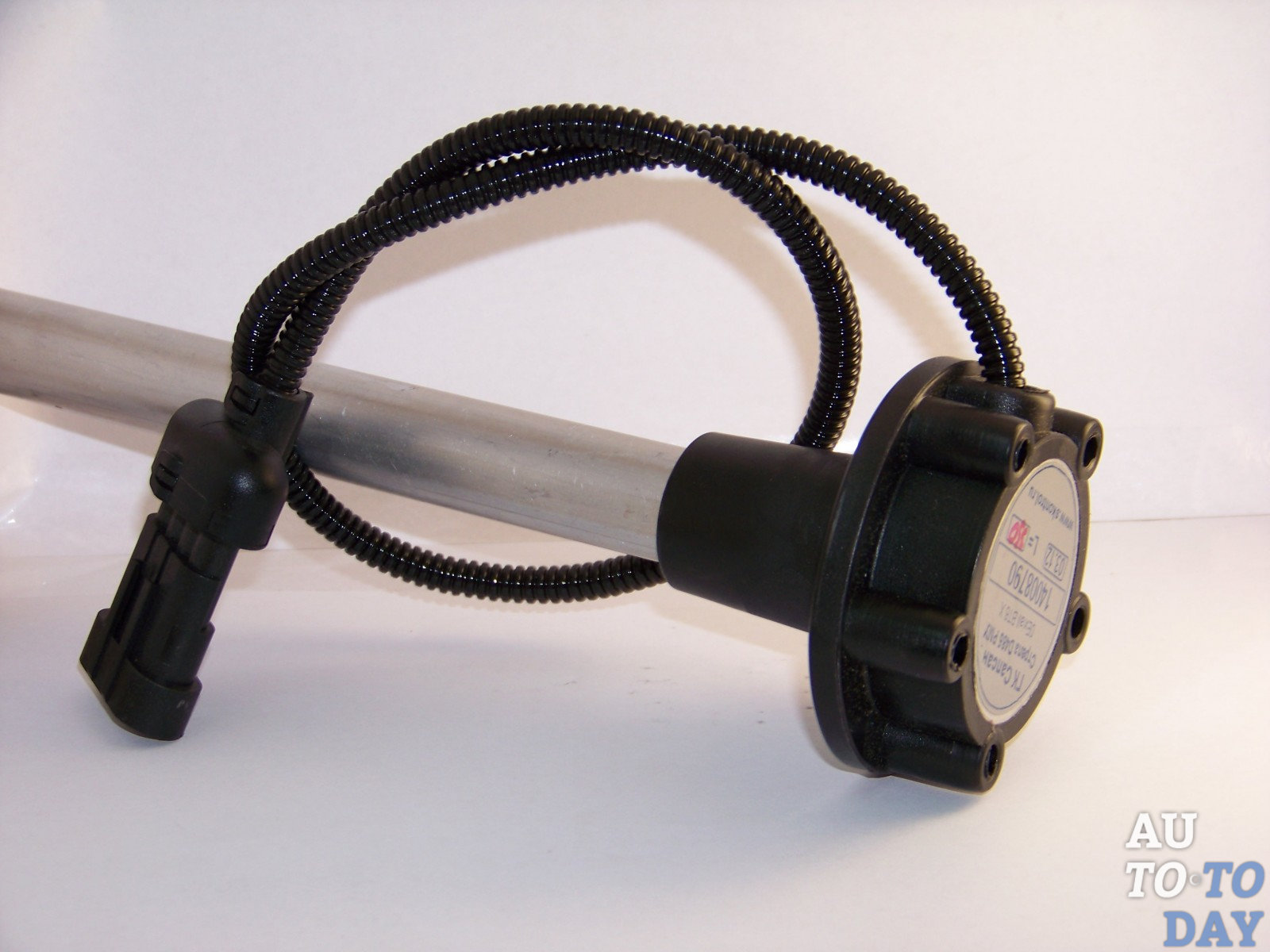 There are two types of potentiometric sensors used today in cars: Lever and tubular. Both the other appearance is equipped with a float, which is always on the fuel surface. This element is made of foam, thin, light metal or plastic hollow. Of course, each of the species has its own characteristics.
There are two types of potentiometric sensors used today in cars: Lever and tubular. Both the other appearance is equipped with a float, which is always on the fuel surface. This element is made of foam, thin, light metal or plastic hollow. Of course, each of the species has its own characteristics.
So, in a lever sensorthe float is connected to the movable contact of the potentiometer (a device that creates the current resistance) due to the metal lever and can be used both separately and enter the fuel supply unit. Because of its design, sensors this type Universal and can be used in any fuel tanks.
Tubular sensor It consists of a tube in which the float moves along the guide, and in parallel it contains wires of resistance with contact rings closed on the float. The main advantage of the sensor of this type is its resistance to fuel drops when turning, lins and descents the car. A negative point is the presence of restrictions in the use, due to the geometric parameters of the fuel tank.
The described types of fuel level sensors are related to contact types, which is absolutely not practical under the use of new types of fuel: ethanol, methanol and biodiesel. It's all about their aggressive influence on the surface of the device, which is why it is quickly wearing. In such cases, it is recommended to use contactless sensors The level of fuel, such as an inactive magnetic position sensor, the sensitive element of which is hermetically closed and not in contact with the fuel.
The fuel level is calculated using a traditional float, connected by a constant magnet lever, which moves along the sector with fixed metal plates of different lengths. The generated magnetic field generates a specific electrical signal corresponding to view Fuel.
Possible malfunctions
 Fuel level sensor, like any other piece of car periodically fails and requires repair work. Now we describe the most frequent reasons This phenomenon. If the sensor readings are changing all the time ("jump") the reason for this may be the wear of contact tracks on the board, which over time is erased due to the continuous movement of the device runner. In the case of not a big erased area, you can try to dry the slider so that it becomes above the erased place, but if the wear area is large, then only replacing the sensor will be solved.
Fuel level sensor, like any other piece of car periodically fails and requires repair work. Now we describe the most frequent reasons This phenomenon. If the sensor readings are changing all the time ("jump") the reason for this may be the wear of contact tracks on the board, which over time is erased due to the continuous movement of the device runner. In the case of not a big erased area, you can try to dry the slider so that it becomes above the erased place, but if the wear area is large, then only replacing the sensor will be solved.
Sometimes, with full tank, the arrow of the pointer returns to the zero indicator. A possible cause of this is the wrong placement of the location limiter.
When the ignition is enabled and the engine running, the pointer arrow remains fixed. Most often, the reason lies in the fuse breakdown, the fault of the pointer receiver (sensor), damage to the connecting wires or the oxidation of their tips.
If the fuel level arrow often drops to zero value, and in the process it also twisted, it is worth checking the current collector, it may be poorly concerning the sensor resistor, or the resistor winding was cut.
Also, a warning warning light on a minimum amount of fuel in the tank, or to work with interruptions can be completely stopped working. In this case, most likely the case in the resistor and it is quite possible to replace it.
The most common problem of potentiometric sensors is the rapid wear and oxidation of the tracks, which determines the appearance of the problems described above.
Repair of the fuel level sensor do it yourself
We have already called possible reasons Fuel sensor breakdowns, now consider ways to deal with them.
And so what to do if the fuel level indicator overlapps (undershits) the real amount of fuel in the tank? First of all, it is worth trying to adjust the sensor. You can do this in two main ways:
move the cylinder pin to extremes, and the arrow on the indicator should also fall into these positions (0 - empty and 1 - full). If the arrow during the extreme position does not want to be installed on "0" or "1", start the pin, leaving it moving and adjust;
you need to disassemble the dashboard and coming through it to the sensor, remove the arrow by connecting the wires back to the device. After that, get the car and let him work about 10 minutes, and then set the pointer axis to the "1" position and connect the index arrow again.
If the sensor hangs on a zero indicator, you should disassemble the dashboard and find the contact wires going to the device. All nuts need to be unscrewed and clean the sandpaper, erases there the most possible oxidation, and then install them for previous places, while tightly spinning. Similarly, you should follow with all the masses on the body (paying particular attention to the mass under the handbag).
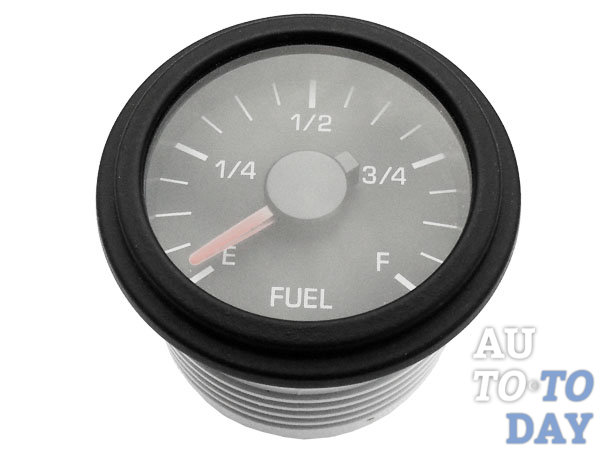 Find out what exactly the problem: in the sensor itself or in the indicator, a special device will help - a multimeter. It is using the indicator diagnostics: with full tank, the approximate resistance value should be about 7 ohms (perhaps a little less), if half is filled - the resistance will range from 108 to 128 ohms; and for complete absence Fuel Multimeter will show a value of 315-345 ohms.
Find out what exactly the problem: in the sensor itself or in the indicator, a special device will help - a multimeter. It is using the indicator diagnostics: with full tank, the approximate resistance value should be about 7 ohms (perhaps a little less), if half is filled - the resistance will range from 108 to 128 ohms; and for complete absence Fuel Multimeter will show a value of 315-345 ohms.
To check the sensor, disconnect the wires going to it and connect the resistance of 330 ohms, then add a 10 Ohm resistor to the chain; Run the engine and you can proceed to measure the resistance on the resistor using the slider (the arrow is floating from the value "empty" to the value "Full").
Before proceeding to repair or replacing the sensor details failed, it is necessary to know exactly where it is and how to repair it in the case of a low pressure level. And it is located at the bottom of the gas tank, so it will have to raise the car to the jack (or take advantage of observation pit) And disconnect contacts. After removing the sensor, first of all, attention should be paid to the state of the tracks, because they are often the first to erase under the influence of the slider.
Subscribe to our ribbons in
The electromagnetic fuel level index consists of a housing, inside of which two coils and anchor with an arrow attached to it are located. Coils are located in the housing at an angle to each other and wound meet. Flat plates, magnetic pipelines are passing from the core of the coil to anchor. Anchor is made of magnetic material, that is, from a material with high magnetic conductivity.
Fuel level indicator Principle of operation.
The principle of such pointers is as follows. When the current is passed through the coil, the magnetotor-visiting force arises directly proportional to the strength of the current. The anchor is magnetized and attracts to that coil magnetic field, which is more. If the magnetiforming power of the coils is the same, then the forces acting on the anchor are balanced. The current passing through the first coil is inversely resistance. The current passing through the second coil is permanent.
When the device is turned off the device, the magnetiforming forces of the coils disappear, and the arrow returns to its original position due to the counterway. Therefore, such devices are strictly oriented and special requirements are put on to their installation.
Fuel Level Index Troubleshooting.
To check the health of the electromagnetic fuel level pointer and the circuit of its connection, it is sufficient to knock the wire to the sensor when the ignition is turned on.
If the device arrow shifts to the extreme right position, then the device and chain are working. In addition, the electromagnetic pointer can be used to display engine oil pressure or tempera cooling fluid.
Good day to all kind people. In the article you can find out principle of operation of the fuel sensor. Types of sensor devices and the principle of its operation.
There is no insignificant detail in the car system. All of them are responsible for the safety of vehicle movement. That is why it is important to carefully follow technical condition Machines, on need to acquire only high-quality auto parts.
One of the most important elements that signal the motorist on the state of the machine is fuel sensor. The sensor is directly in the fuel tank and shows the fuel level. The sensor operates in a system with a fuel level pointer, which is placed on the instrument panel.

1.Potensiometric.

Sensor installed on modern carsHis advantage consists in fairly expected characteristics: imperious design, accurate measuring fuel consumption indicators, low cost.
However, mobile contacts included in the design require close attention to themselves, since it is subject to wear and oxidation that eliminates simple repair or replacement.
Potentiometric sensors are two types - lever and tubular. The fuel level sensor in them will be float, located on the surface of the liquid.
2.Beskontal.
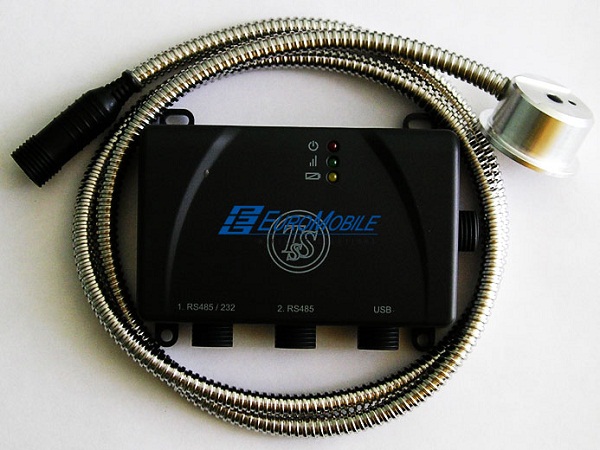
For example, an inactive magnetic position sensor (MAPPS). The emergence of this model is due to the popularity of new fuels for engines. internal combustion (ethanol, biodiesel, methanol).
In this case, the contact sensor will be ineffective and may incorrectly display the data, besides, the features of the medium will accelerate the wear of the contact surface.
A distinctive feature of such a sensor will be a hermetic isolation of the sensing element, although it is also made in the form of a float connected to the lever with a magnet that moves through the sector. The fuel level is determined using a special signal generated by a magnetic field.
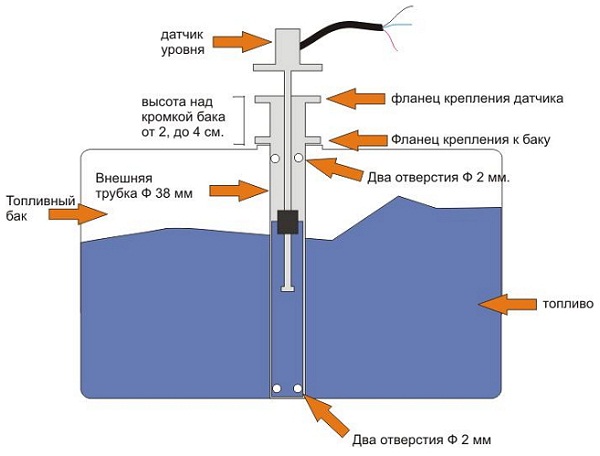
It is quite simple - the sensor responds to the fuel level, and each volume corresponds to a certain signal. So designed a standard sensor. Modern models More complex and adapted to the body space.
Cost one important feature of all tanks. Levels will be displayed only when the fuel drops below a particular face. That is, passing the lower line of each level, the amount of fuel will be visible.
In addition, a long time the sensor will show that fuel tank Polon, since the indicator feature will not be passed, and the flow will begin. Therefore, it is worth being prepared for the fact that all sensors have a certain error of the indicator. This happens due to fluctuations in the fuel level and the characteristics of the geometry of the tank.
Types of Signal Signal
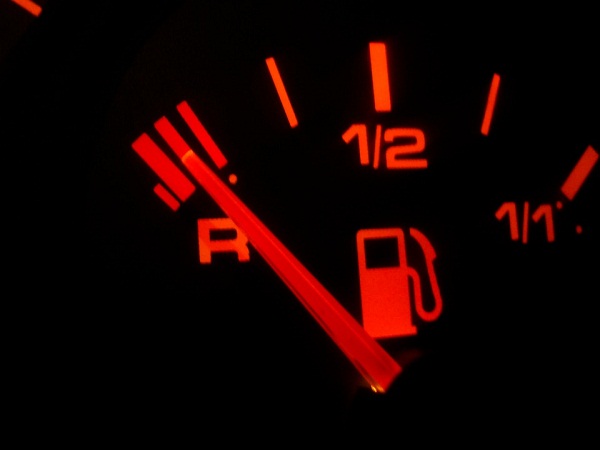
1. Analog.
Shows the change in the voltage on the potentiometer, and, unfortunately, they have a higher measurement error. Because of this, they are increasingly refused by car manufacturers.
2.Siferous.
A more perfect signal that is capable of converting an analog indicator, while equalizing the measurement error, which was previously said. Today, sensors with a digital signal are considered the most accurate, and the error is observed in the initial physical measurement of fuel.
The serviceability of this item is extremely important, since failures in its work may entail an incorrect understanding of the car's work. In turn, this will entail faults that may require serious diagnosis and possibly expensive repairs.
Therefore, it is important to monitor the condition of the sensor, and if necessary, buy a qualitative replacement.
It is interesting
What is myself gas engine?
Features of work mechanical box Transmissions in different operating modes
What is the intercooler in the car?
Principle of operation pump-nozzle
In order not to stay in the middle of the road without fuel, you need to know the level of fuel in the tank. This will help determine whether it is time to visit the refueling, or the fuel supply allows you to go further. The fuel sensor operation is based on the principle of determining the volume when the height (level) is changed. The size of the fuel tank is unchanged, therefore, some amount of fuel corresponds to a certain height of the level of diesel or gasoline.
Device and principle of fuel level sensor
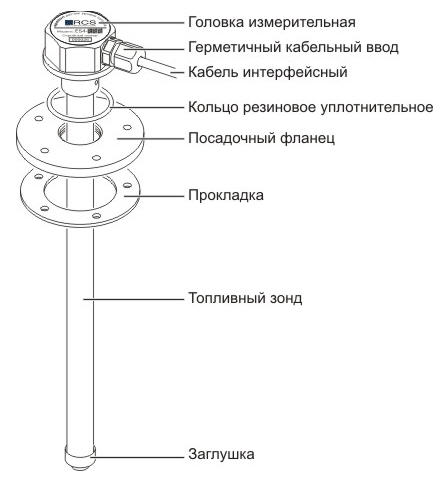
The basis of the sensor - the float, which is always on the fuel surface. The float with a steel bar is associated with a resistor with variable resistance installed inside the sensor housing. With increasing or changing the fuel level, the sensor resistance changes. Sensors are also used, where the rod (wire holder) is not directly related to the resistor, and transmits it with information with a magnet and elements sensitive to it.
Sensors are also found, which determine the filling of the tank on the principle of the radar - are sent to the ultrasonic impulse to the tank and the time and the number of reflections from walls and fuel are seeded. But such devices apply only on new enough expensive cars. In order to eliminate such a sensor malfunction, serious diagnosis is needed using a specialized computer stand.
One more fairly common on expensive cars The fuel level sensor works on the principle of an electrical capacitor. It consists of two tubes inserted one to another, and large quantities of holes to speed up the fuel sensor filling. Gasoline and diesel engineer on electrical conductivity differ from the air, so the fuel can change the capacitor capacitance between the tubes.
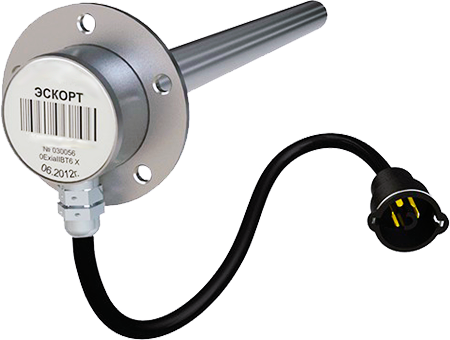
Therefore, with a decrease in the level of fuel, the capacitance of the capacitor formed by two tubes, evaporation and liquid fuel increases. The accuracy of such devices is noticeably higher than mechanical (with float), but in order to track the fuel level, not only the sensor is needed, but also the corresponding programmable indicator. Therefore, to configure the entire system, specialized computer equipment is required. But such sensors have advantages - the technology of removal and installation is the same as for mechanical.
In the machines without an on-board computer, the signal from the fuel sensor is processed electronic circuit And the fuel level is displayed on the dashboard indicator.
The accuracy of such a level of fuel level is small, so the error reaches 20 percent. In cars with an on-board computer, the signal from the fuel level sensor enters an analog-to-digital converter, where it is converted to digital code. On-board computer Processes the converted signal and displays readings on the dashboard. The error of such a method for determining the amount of fuel in the fuel tank does not exceed 5 percent.
Fault sensor fuel
The most frequent malfunctions of the fuel sensor:
- loss of tightness float;
- bending wire holder;
- violation of the tightness of the body and the resistance reduction caused by it;
- breaking a variable resistor;
- loss of tightness of the sensor mounting to the fuel tank body.
When the float loses hermeticity, the sensor even when the tank is filled under the cover shows an incomplete level of fuel. With severe tightness loss, the indicator always shows the minimum level of fuel, regardless of its real number. To eliminate this malfunction, you need to remove the sensor and replace the float. If the float cannot be purchased, you will have to completely replace the sensor.
While driving around the rough terrain, when hitting the fuel tank and accident, damage to the wire holder is possible. The behavior of the fuel level indicator depends on which side the holder curved. If up, the amount of fuel on the indicator will always be enlarged. If down, then reduced. To troubleshoot a malfunction to straighten the holder, giving it the original form or replace the sensor
Violation of the tightness of the fuel level sensor housing occurs after an accident or when used embossed fuel. Depending on the settings of the indication system, the fuel ingress into the sensor leads to an increase or decrease in the indicator readings. To troubleshoot a malfunction, replace the sensor.
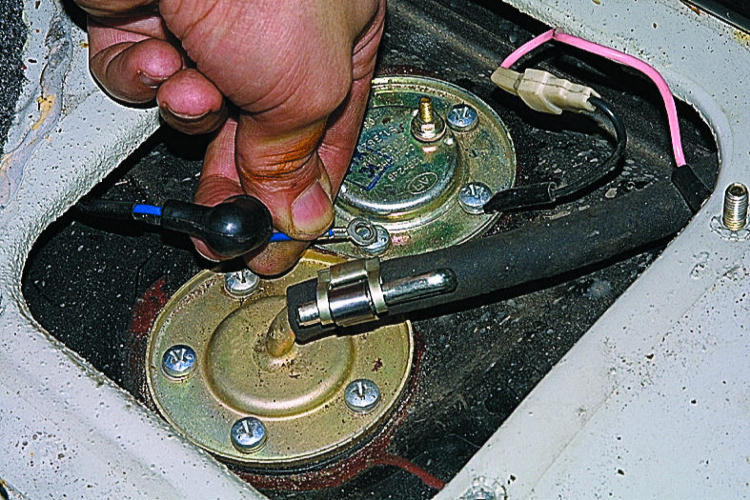
The breaking of the variable resistor leads to the fact that, regardless of the amount of fuel, the indicator shows an absolutely empty or filled with a tank. The same symptoms are observed when the signal wire breaks from the sensor to the indication unit. Before removing the sensor, it is necessary to connect to the signal contact and car body a variable resistor resistance 100-200 Ohm and rotating its handle, make sure that the indicator readings are changed. To troubleshoot a malfunction, you need to replace the sensor.
A sign of the loss of tightness in the location of the sensor and fuel tank is the smell of fuel in the cabin.
To make sure that the problem is in loss of tightness, remove the trunk mats and inspect the location of the sensor. If the fuel traces are visible around, it is necessary to restore tightness. In addition to loss of tightness, a strong smell of fuel in the cabin can damage the fuel tubes and hoses.
Replacement DUT.
How to remove the sensor
On the petrol cars Disconnect the minus battery terminal. On the diesel cars This procedure is desirable, but optional. Open the trunk and unload all the contents from it. Remove all mats to get to the bottom. On some cars, a protective plate is installed on some cars on top of the fuel level sensor and the location of the fuel tubes. Remove the bolts and remove it.
Clean the dirt, dust and rust sensor and space around it. Disconnect all sensor wires (be sure to mark them so as not to confuse when installing). Remove the bolts that the sensor is attached to the fuel tank and remove it. On some cars, the sensor is fixed with a plastic screwing lid. To remove it, you must unscrew the cover, after which it is careful not to damage the float or holder, pull out the sensor from the tank.
How to install a sensor
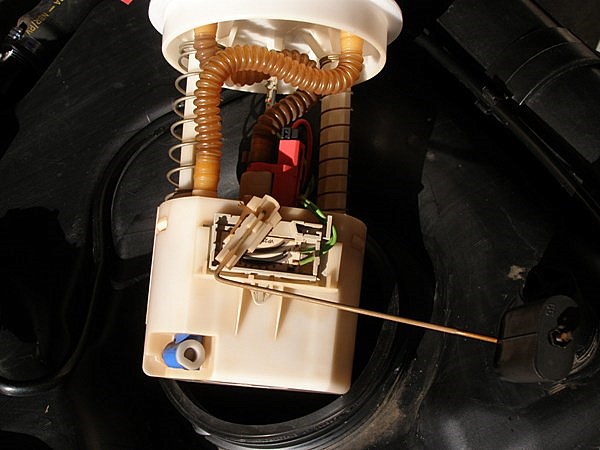
Clean the remnants of sealant planting place Sensor. If you bought a new sensor and with it included rubber gasket, then put it on the fuel tank to combine the bolts, then insert the sensor to the tank (do not confuse the float direction). Tighten all the bolts, then tighten them. If included with the sensor there is no new seal, then use the old one. To do this, spread the place to set the sensor with a thin layer of automotive sealant, put the seal from above, align the bolts holes.
Also flash the sealant from above, then insert the sensor, align the bolts and tighten them. If a car is more than 15 years old, it is desirable even with a new seal to use a sealant. Connect all the wires, connect the battery, turn on the ignition and see the indicator readings. To check the sensor for leakage, you need to drive at least 30 km, after which it again to remove the trunk mats and take it again. If there are no leaks, you did everything right. Fill gasoline to the maximum and see if the indicator readings changed? If the indicator tells that the full tank, you did everything right.
Video - Replacing the benzonasos mesh and amid on VAZ

